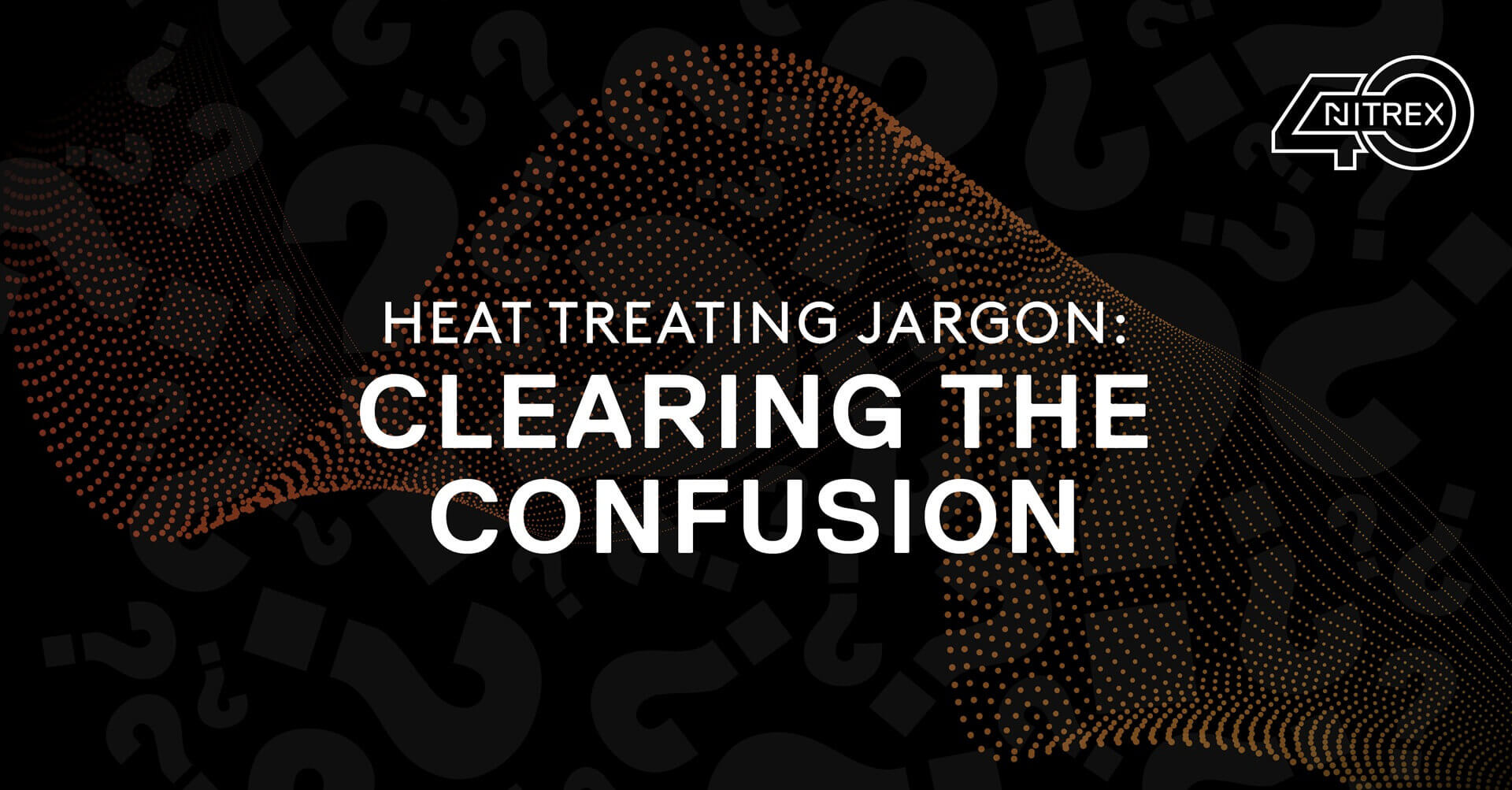Heat treating involves a variety of technical terms, which can make it easy to get lost in the jargon. Some words appear similar or have overlapping functions, and some are used interchangeably—sometimes incorrectly. Keeping them straight can be challenging! To help you navigate these terms and use them correctly, here’s a helpful and straightforward guide.
1. Heat Treatment vs. Surface Treatment
When it comes to improving the performance and longevity of metal components, heat treatment and surface treatment are two distinct but often compared methods. Here’s how they differ and what each achieves.
- Heat Treatment: This involves carefully controlling the heating and cooling of metal to change its internal structure and improve its mechanical properties. Heat treatment is essential for improving strength, wear resistance, and toughness, and it can be tailored for specific material needs.
- Surface Treatment: This includes processes like coating or plating that add a protective layer to the material’s surface, helping prevent corrosion and improving the part’s appearance. It’s commonly used in aerospace and automotive parts to enhance longevity and aesthetics.
2. Annealing vs. Normalizing
Although both processes involve heating and cooling metals, annealing and normalizing serve distinct purposes and deliver different results.
- Annealing: This heat treatment process softens metal and enhances its ductility by heating it to a specific temperature and then cooling it slowly. It’s a key step for reducing internal stresses that could otherwise affect the material. It’s perfect when you need to give metal the flexibility to bend and form easily without breaking.
- Normalizing: While similar to annealing, normalizing involves cooling the material in the air rather than inside a furnace. This process results in a more uniform structure and improves the material’s mechanical properties, making it stronger and tougher. Think of it as giving the metal a more consistent structure, perfect for creating uniform parts.
3. Quenching vs. Tempering
Quenching and tempering are closely linked processes in heat treatment, but they serve very different purposes. Together, they create a balance between hardness and toughness in metals.
- Quenching: This process rapidly cools metal—typically in water, oil, or air—after it has been heated to a high temperature, locking its structure into place. It’s often used when a material needs to be very hard but still able to endure wear and tear.
- Tempering: After quenching, tempering is used to reduce brittleness and improve toughness. By reheating the hardened metal to a lower temperature, it allows the structure to relax just enough to improve toughness while maintaining much of the hardness from the quenching process. This makes sure the metal is strong but not prone to shattering.
4. Hardening vs. Case Hardening
Hardening and case hardening both aim to improve the durability of metal, but they differ in how they affect the material’s surface and core.
- Hardening: This straightforward method increases a material’s hardness by heating it to a high temperature and then then rapidly cooling it Quenching and induction hardening are common treatments that offer different levels of hardness, making them ideal for producing tools and parts that need to withstand constant use and wear.
- Case Hardening: Unlike full hardening, this process is all about strengthening the outer surface (or “case”) of a metal, while leaving the core softer and more ductile. Processes such as carburizing, nitriding, and nitrocarburizing are common case hardening treatments. These are particularly useful for parts like gears and shafts that need an extra layer of protection from wear, where the surface bears the brunt of the action, but the inner core still needs flexibility.
5. Carburizing vs. Nitriding
Both carburizing and nitriding are surface-hardening processes that enhance a material’s wear resistance, but they differ in the elements they use and their typical applications.
- Carburizing: In this process, carbon is added to the surface of steel by heating it in a carbon-rich environment at high temperatures. This increases the surface hardness of the material, making it more resistant to wear and tear. It’s often used when you need a tough exterior but want to preserve the inner strength of the material.
- Nitriding: This involves adding nitrogen to the surface of steel, typically at lower temperatures than carburizing. Nitriding creates a surface that’s not only hard but also resistant to corrosion without the need for quenching, making it ideal for precision components that will be exposed to harsh environments such as engine parts and tooling, where dimensional stability is preferred.
6. Carburizing vs. Nitrocarburizing
Both processes are designed to harden the surface of steel, but they differ in their mechanisms and the properties they impart.
- Carburizing: Refer to the description in point 5 above.
- Nitrocarburizing: In addition to carbon, nitrocarburizing introduces nitrogen into the surface layer of steel. This process results in a deeper, more durable case, offering improved fatigue and corrosion resistance compared to carburizing alone. It is commonly used for automotive parts like pistons and camshafts, where both hardness and corrosion resistance are crucial.
7. Vacuum Heat Treatment vs. Atmospheric Heat Treatment
Both heat treatment methods are designed to alter the material’s properties, but they differ in how they control the environment to achieve specific results.
- Vacuum Heat Treatment: This method is performed in a vacuum chamber, meaning no oxygen can come into contact with the metal, eliminating the risk of oxidation and contamination. It’s perfect for high-purity applications where you need to ensure the metal comes out clean and uncontaminated. It’s commonly used for high-performance components, such as aerospace or medical parts.
- Atmospheric Heat Treatment: In contrast, atmospheric heat treatment takes place in a controlled atmosphere, where nitrogen or other gases are carefully chosen to alter the metal’s surface properties, like we do with carburizing and nitriding. The result is a more tailored heat treatment, allowing for precision when it comes to surface durability, hardness, or other specific characteristics.
8. Toughness vs. Hardness
Toughness and hardness are two material properties that are often confused, but they represent different aspects of a material’s performance.
- Toughness: This is the ability of a material to absorb energy and resist breaking under stress. It indicates how well a material can withstand the impact of sudden forces without breaking.
- Hardness: Hardness refers to a material’s resistance to surface deformation, like scratching or denting. Hard materials are essential in parts that undergo constant friction or wear, like gears and cutting tools.
9. Oxidation vs. Decarburization
Oxidation and decarburization are distinct surface phenomena that can occur during heat treatment, each affecting the quality of the material in different ways.
- Oxidation: When metal is exposed to oxygen at high temperatures, it forms an oxide layer on the surface. This can lead to surface discoloration, reduced strength, and potential loss of material integrity. Preventing oxidation is critical for ensuring the metal remains clean and free from impurities that could weaken its properties.
- Decarburization: During heat treatment, metals can lose carbon from their surface due to exposure to high temperatures. This can weaken the material, making it softer and less resistant to wear and fatigue. Decarburization is a process that reduces this effect, ensuring the metal retains its desired hardness and strength.
10. Martensite vs. Bainite
Both martensite and bainite are microstructures that form during the cooling of steel, but they differ in their formation and the properties they impart to the material.
- Martensite: Formed through rapid cooling (quenching), martensite is a hard, brittle structure that enhances the hardness of steel. It’s ideal for parts that need exceptional wear resistance but may require additional tempering to reduce brittleness. It’s commonly found in tools, blades, and other high-performance components.
- Bainite: This microstructure forms at slower cooling rates and offers a balance between strength and toughness. It’s tougher and more resistant to cracking compared to martensite, making it suitable for automotive and structural applications where both durability and impact resistance are essential.
11. Ferrite vs. Austenite
Ferrite and austenite are two distinct phases of steel, each with its own characteristics and role in different heat treatment processes.
- Ferrite: A softer, ductile phase of steel that’s stable at lower temperatures. While not as strong as other phases, ferrite’s properties make it ideal for low-carbon steel applications requiring good formability–easier to shape–and weldability.
- Austenite: This high-temperature phase of steel plays a key role in processes like quenching. It has a higher carbon solubility, allowing the steel to transform into harder phases, such as martensite, when cooled rapidly. This transformation is crucial for enhancing strength and hardness.
We hope this quick guide helps clarify the differences between some commonly confused heat-treating terms. With the proper context, you’ll be able to make the right choice for your specific heat treatment needs. If you’re unsure about which process is best for your application, feel free to reach out to us using the web form for guidance.


